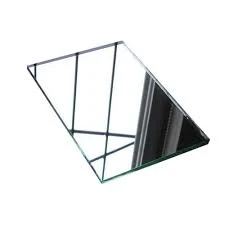

The Allure of Green Reflective Glass A Modern Architectural Choice
In the realm of contemporary architecture, the materials used can profoundly influence not only the aesthetic appeal of a structure but also its functional performance. Among these materials, green reflective glass has emerged as a popular choice for architects and builders alike, blending elegance with practicality. This article explores the significance of green reflective glass, its benefits, and its applications in modern design.
Understanding Green Reflective Glass
Green reflective glass is characterized by its green hue and reflective surface, which can vary in intensity depending on the manufacturing process. The green tint often emerges from the iron content in the raw materials, and the reflective quality is achieved through the application of a thin metallic coating. This combination creates a unique visual effect that not only enhances the building's exterior but also contributes to energy efficiency.
Aesthetics and Design
One of the primary reasons architects are drawn to green reflective glass is its striking visual appeal. The green tint offers a sophisticated alternative to traditional clear glass, providing a unique identity to the structure. It pairs beautifully with a variety of architectural styles, from sleek modern designs to more traditional settings. When sunlight hits the surface, the reflective quality creates a dynamic interplay of light and shadow, adding depth and interest to the facade.
Moreover, the color green is often associated with nature, growth, and tranquility. By integrating green reflective glass into their designs, architects can foster a sense of harmony with the environment. This connection is particularly important in urban areas, where natural landscapes may be limited. The glass invites greenery and the surrounding environment to become part of the architectural narrative, blurring the lines between nature and urban living.
Energy Efficiency and Sustainability
In addition to its aesthetic qualities, green reflective glass is highly valued for its energy-efficient properties. The reflective surface helps to reduce the amount of solar heat that enters the building, minimizing the need for air conditioning in warmer climates. This can lead to significant energy savings and lower utility bills for building occupants.

Furthermore, the use of green reflective glass can contribute to a building’s overall sustainability. By improving energy efficiency, it reduces the carbon footprint associated with climate control. Many green building certifications, such as LEED (Leadership in Energy and Environmental Design), recognize the use of reflective glass as part of a sustainable design approach. Architects and builders can incorporate these materials into their projects to not only meet regulatory requirements but also to enhance their reputation as environmentally responsible designers.
Noise Reduction and Comfort
Another advantage of green reflective glass is its ability to provide sound insulation. The thickness of the glass and its reflective properties can help attenuate external noise, making it an ideal choice for buildings located in busy urban areas. This added comfort allows occupants to enjoy a quieter indoor environment, which is essential for productivity and well-being.
Applications in Modern Architecture
Green reflective glass is becoming increasingly popular in various building types, from commercial skyscrapers to residential homes. In commercial buildings, large expanses of green reflective glass can create an impressive visual statement while also contributing to energy savings. Many high-rise offices utilize this glass to reduce glare for occupants while providing panoramic views of the city.
In residential projects, green reflective glass can be used on windows, doors, and facades, allowing homeowners to enjoy natural light while maintaining privacy. The material also pairs well with various framing options, offering the flexibility to complement different architectural styles.
Conclusion
The increasing popularity of green reflective glass in modern architecture is a testament to its unique blend of beauty, functionality, and sustainability. As architects and builders continue to seek materials that not only meet aesthetic goals but also support energy efficiency and environmental responsibility, green reflective glass stands out as an exemplary choice. Its ability to harmonize with the surroundings while providing tangible benefits makes it a material of choice for the future, promising to shape the skyline of our cities for years to come. Whether in commercial or residential projects, the allure of green reflective glass remains undeniable, illustrating the intersection of nature and modern design.